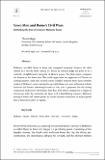Files in this item
Sown Men and Rome’s civil wars : rethinking the end of Melinno’s Hymn to Rome
Item metadata
| dc.contributor.author | Biggs, Thomas | |
| dc.date.accessioned | 2022-06-15T12:30:09Z | |
| dc.date.available | 2022-06-15T12:30:09Z | |
| dc.date.issued | 2022-05-18 | |
| dc.identifier | 279998890 | |
| dc.identifier | b2312685-08b5-49be-ad0a-c4221361dd25 | |
| dc.identifier | 85131359940 | |
| dc.identifier.citation | Biggs , T 2022 , ' Sown Men and Rome’s civil wars : rethinking the end of Melinno’s Hymn to Rome ' , Mnemosyne , vol. Advance Articles . https://doi.org/10.1163/1568525x-bja10033 | en |
| dc.identifier.issn | 0026-7074 | |
| dc.identifier.other | Jisc: 377465 | |
| dc.identifier.uri | https://hdl.handle.net/10023/25537 | |
| dc.description.abstract | Melinno’s so-called Hymn to Rome was composed sometime between the third century BCE and the third century CE. Nearly all scholars judge the poem to be a relatively straightforward panegyric of Rome’s power. The final stanza compares the Romans to the Sown Men. This article argues that the appearance of Theban or Colchian Spartoi could have evoked a more complex response from many probable readers of Melinno’s poem in antiquity, especially those who were well versed in Latin literature and Rome’s harrowing histories of civil war. It proposes that the closing comparison underscores the Romans’ fatal flaw: their inborn compulsion to engage in internecine strife. By concluding the hymn with a destabilizing reference, Melinno’s linking of Rome and Thebes points to a more nuanced evaluation of Roman power than scholars have yet to recognize. | |
| dc.format.extent | 19 | |
| dc.format.extent | 361875 | |
| dc.language.iso | eng | |
| dc.relation.ispartof | Mnemosyne | en |
| dc.subject | Melinno | en |
| dc.subject | Rome | en |
| dc.subject | Thebes | en |
| dc.subject | Sown Men | en |
| dc.subject | Civil war | en |
| dc.subject | Reception | en |
| dc.subject | Vergil | en |
| dc.subject | DE The Mediterranean Region. The Greco-Roman World | en |
| dc.subject | T-NDAS | en |
| dc.subject.lcc | DE | en |
| dc.title | Sown Men and Rome’s civil wars : rethinking the end of Melinno’s Hymn to Rome | en |
| dc.type | Journal article | en |
| dc.contributor.institution | University of St Andrews. School of Classics | en |
| dc.contributor.institution | University of St Andrews. Centre for Late Antique Studies | en |
| dc.contributor.institution | University of St Andrews. St Andrews Centre for the Receptions of Antiquity | en |
| dc.identifier.doi | 10.1163/1568525x-bja10033 | |
| dc.description.status | Peer reviewed | en |
This item appears in the following Collection(s)
Items in the St Andrews Research Repository are protected by copyright, with all rights reserved, unless otherwise indicated.

